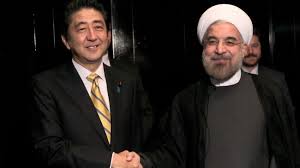Japan's role in Iran's energy sector
Regardless of how well European oil companies were successful in penetrating Iran's oil market, Japan's oil giants have had restricted ties with Iran's energy projects, mostly focused on a petrochemical plant and an oil field.
However, regarding the fact that the world's third economy, Japan, is the second biggest direct investor in the world after the U.S. and has progressive high technologies, Iran can enjoy cooperation with the Japanese in the energy sector.
Official statistics show Japan’s outflow foreign direct investment (FDI) stood at roughly $119 billion in 2014, down from $135 billion in 2013.
A Japanese delegation led by State Minister of Economy, Trade and Industry Daishiro Yamagiwa arrived in Tehran on Aug.8 for a two-day visit and held talks with Iran's senior officials, including Oil Minister Bijan Namdar Znganeh. The delegation comprises trade officials and executives of major Japanese industries such as Mitsui & Co., Kansai Paint Co., Sanden Holdings, Nippon Steel, Sojitz, ITOCHU and Kamematu.
Among the delegation, 21 energy-related companies visited Iran, according to Iranian media outlets.
Before sanctions were imposed on Iran during Mahmould Ahmadinejad's presidency (2005 to 2013), alongside several Japanese financial entities and banks, Inpex and Mitsui Engineering & Shipbuilding companies had been involved in Iran's energy-related projects.
After years of negotiation, Japans Inpex Company agreed in 2004 to invest 75 percent of a $2 billion plan to develop Azadegan oil field. But two years later, Iran cut Inpex's share to 10 percent, complaining that the firm was delaying on the project and the company left Iran in 2010 due to the U.S. sanctions.
Azadegan was the OPEC member's biggest oil find in 30 years when announced in 1999, with oil-in-place of 26 billion barrels and recoverable resources then estimated at about 6 billion barrels.
However, Mitsui Engineering & Shipbuilding Co., which had signed agreement with Iran simultaneously with Inpex to develop a $280 million worth the high-density polyethylene-petrochemical (HDPE) plant in Ilam province, completed that in 2010. This plant produces 300,000 tons of HDPE annually.
Iran needs $185 billion and $70 billion in upstream oil and gas projects as well as petrochemical projects respectively by 2020.
Japan's outflow FDI in Middle East was restricted to about $406 million in Saudi Arabia and $84 million in UAE last year, however, in total this volume for Asian countries was above $20.3 billion.
During the 1Q15, Japan's outflow FDI in Saudi Arabia and UAE reached $491 million and $34 million, while the total outflow FDI reached $31.2 billion.
Japan's total outflow FDI stock stood above 1.2 trillion at the end of 2014, while this figure for Iran was only $5 million.
Japan was the only Iranian Asian client that increased crude oil intake from this country in the first half of 2015.
Japan, Iran's third biggest client, increased oil purchase from Iran by 0.4 percent in Jan-June to 172,803 barrels per day, while China, India and South Korea decreased oil import from Iran by 6.1 percent, 22.9 percent and 4.3 percent respectively, according to the Reuters survey.
Seyed Mohsen Ghamsari, executive director for international affairs at the National Iranian Oil Company said Aug.9 that Iran ready to resume oil export to Japan after elimination of sanctions.
Iran and P5+1 reached a nuclear deal on July 14, which paves the ways for lifting sanctions on Iran by the end of 2015.
Before sanctions, Japan was importing 315,000 barrels per day of Iranian crude oil.
According to Iran Custom Administration's latest monthly report, the country increased non-oil exports to Japan by 14.26 percent to 11.13 million, while imports from Japan increased by 41.87 percent to $82.122 million in the first four months of current fiscal year, started on March 20.


Comments
Post a Comment